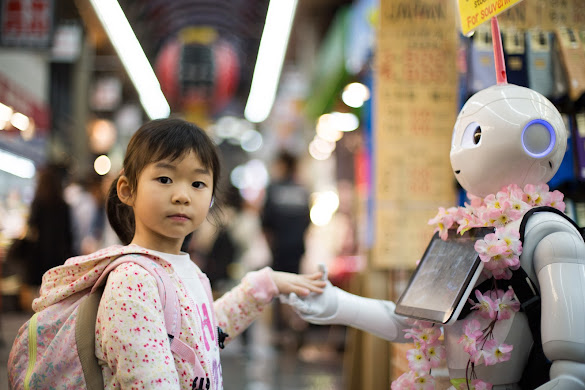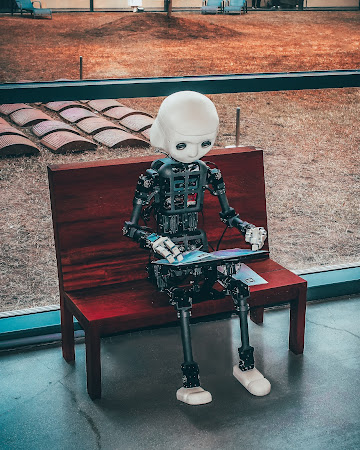How does artificial intelligence work?
I – What is artificial intelligence? (Definition of AI)
There is no universally accepted definition of artificial intelligence. First, because it is a new, evolving, and experimental science. Second, we can't even define exactly what human intelligence is... In its simplest form, AI is the attempt to imitate human intelligence using a robot or computer. software to replace tasks that humans can perform, but also tasks that surpass them.
A – General artificial intelligence
Since the beginning of artificial intelligence in the 1950s, engineers have imagined intelligent machines or robots that could be able to perform all kinds of tasks, switching easily from one to another. AGI or Artificial General Intelligence is referred to systems that can think, learn, reason, plan, understand human language, and demonstrate logic at the height of human abilities. However, AGI is now the subject of debate in the scientific community and is still far from becoming a reality in practice.
B- Strong VS weak artificial intelligence
Experts have divided artificial intelligence into two categories: strong artificial intelligence and weak artificial intelligence. The difference between these AIs lies partly in the level of intellectual capacity of a computer program. Weak artificial intelligence is also called narrow. Concretely, faced with a problem, the latter can act like human reasoning. It can perform calculations, process a large volume of data, and learn in an automated way, but has no consciousness of its own. On the other hand, strong artificial intelligence, or general AI, refers to a model designed to think like a human and is not limited to a single task.
C – Artificial superintelligence
There is also another form of AI: artificial superintelligence. This category designates a level that surpasses the intellectual level of humans. However, this is far from being reached, since the general AI is not even yet. Indeed, the systems developed to date correspond rather to a weak AI. While some programs are capable of performing different tasks, they cannot yet do so simultaneously. This is the most ambitious AI project.
II – How does artificial intelligence work?
Just like human intelligence, artificial intelligence works through the interconnection of a neural network. Experts created precise equations with variable parameters. The equations are interconnected which then allows artificial intellectual stimulation. Concretely, the knowledge of AI results from these equations, which are also called operating units. These constantly enrich each other and work together. Thus, this artificial neural network integrates the data that the human wishes to process.
Equations extract the most important information. With this interconnection of artificial neurons, artificial intelligence is similar to the functioning of the human brain. The advantage is that the AI becomes more and more efficient as it experiments, identifies, and analyzes the data. Each elapsed second allows him to refine his sensory or motor capacities. This is the very principle of Machine Learning, we then speak of autonomous learning.
A – The Turing Test to determine if a machine can think
To determine whether artificial intelligence equals the capabilities of a human, it should be able to make us believe that it is itself one. Thus, we should not be able to distinguish a solution provided by a computer program from that provided by a human. The Turing Test, introduced by Alan Turing, was designed to test a machine's ability to show signs of human intelligence.
#III – What is the purpose of artificial intelligence?
The purpose of artificial intelligence is to improve business performance and productivity by automating processes or tasks that normally require human resources. AI technology also makes it possible to exploit data, that no human would be able to exploit. Planning, setting goals, achieving them, solving problems, and performing complex or repetitive tasks with low added value, this is what artificial intelligence is supposed to do. The objective is also to develop a strong synergy between AI and humans so that they can work together and improve each other's abilities.
A – The techniques of artificial intelligence
Artificial intelligence (AI) takes into account a set of concepts and technologies. To better understand how artificial intelligence works, find out what its bases and associated materials are.
B – What are the bases of artificial intelligence?
Artificial intelligence is made up of algorithms, which designate processes or sets of rules that a computer can execute. AI algorithms can learn from data.
C – What are the 3 scientific themes associated with artificial intelligence?
AI combines hardware and software and mobilizes multidisciplinary knowledge. In particular, it calls on computational neurobiology (particularly Neural Networks), mathematical logic (data analysis models), and computer science (data processing, deep learning). It also uses the human and social sciences to analyze the societal impact induced by these new uses.
IV – Examples of uses related to artificial intelligence processes
Artificial intelligence is spreading at high speed in human activities and is already changing the way businesses operate. It nestles in all areas of activity without our really being aware of it. Here is a list of examples of uses of AI across different fields.
A – In the IT sector
You have probably already typed a search on a search engine and made a typing (or spelling) error. In this case, you should have seen the result appear with the correct spelling. It is actually the algorithms of Artificial Intelligence (AI) that allow this correction by using Machine Learning with Deep Learning and NLP.
B – In the distribution and logistics sector
The supply chain has several stages that can sometimes be complex to manage. The use of technology such as AI then makes it possible to optimize these steps. For example, knowing the location of products allows teams to be faster and more efficient. In particular, AI can assist humans in implementing better inventory management. In this area, AI thus makes it possible to avoid sources of error and to obtain considerable savings in time and money.
C – In the health sector
Medical research is going through a digital revolution in the face of a large amount of data, our ability to collect and store it, but also to process it. The operation of artificial intelligence in the field of health is thus very promising. This technology would notably improve the quality of care. AI is at the heart of the medicine of the future, with assisted operations, and programs capable of early detection of cancers or even mental illnesses such as schizophrenia.
D – In the customer relations sector
In the customer relationship sector, let us mention in particular chatbots. These solutions favored by companies make it possible to move towards an increasingly personalized customer relationship. Chatbots learn to mimic the conversational styles of customer representatives, using natural language processing (NLP). Thanks to the operation of artificial intelligence, chatbots can then answer complex questions, which require detailed answers.
E – In the automotive sector
AI is also increasingly used in the field of smart cars. Many manufacturers plan to integrate it into automobiles to provide seamless services of various technologies, such as traffic information or real-time updates on roadblocks. AI is also at work in autonomous vehicles.
F – In the streaming industry
You may have noticed that over time, the playlists suggested on your music app or Youtube recommendations become more and more relevant, in line with your tastes. It's all about the AI, which closely tracks the videos and music you listen to the most in order to suggest content you might like.
G – In the security sector
In this sector, the idea of artificial intelligence is notably surveillance on a larger scale. For example, monitoring a large stream transmitted by cameras and other devices. AI uses face, object and location recognition to control and analyze entrances (airports, stadiums, etc.).
H – In the financial sector
Banks and financial institutions use AI to detect fraudulent activity, analyze customer investment trends, and provide customer service. In the banking sector, this technology is also used to understand your preferences, your requirements and your financial strength, in order to suggest relevant products to you. Artificial intelligence, in addition to spotting fraud, is able to detect money laundering.
V – What are the advantages of artificial intelligence technologies?
Artificial intelligence is like a super assistant. It collects, sorts, analyzes data, learns like a human and adjusts autonomously. You now know how artificial intelligence works and what are its areas of intervention. Find out now what its advantages are!
A – AI limits errors
Systems based on artificial intelligence algorithms work on the basis of previous records and decisions. As a result, machines and applications have the ability to solve problems in less time and with a lower error rate. AI also reduces failures due to human limitations. In some production lines, AI is used to detect, through infrared sensors, small cracks or flaws in parts that are undetectable by the human eye.
B – AI allows working 24/7
Unlike humans, robots created using AI can be designed to work in normal or extreme environments without the need for breaks. They can work alone for long hours without interruptions and distractions. Since their efficiency is not influenced by internal or external factors, they can perform difficult and repetitive tasks with less wear and tear.
C – AI offers more rationality
Another advantage of artificial intelligence is the absence of emotions and the use of greater rationality. This feature allows these systems to make effective decisions without hesitation. Since they don't have a sentimental side, they can develop finer logic and produce more efficiently. An example of this can be seen in the healthcare sector, where AI tools have improved treatments and reduced the risk of false diagnoses.
D – AI saves time
Artificial intelligence reduces the time spent analyzing data. Having more information in a structured way allows each of the managers to make decisions more quickly and efficiently. AI also makes it possible to imitate human actions more quickly, which allows humans to free themselves from certain repetitive and tedious tasks.
E – What can we learn from the functioning of artificial intelligence?
Artificial intelligence is omnipresent in our lives and we are currently at the beginning of a new era in which algorithms are spreading in all economic sectors. It is undoubtedly thanks to the massive amount of data available that we have been able to allow artificial intelligence to reach its current capabilities.
This technology is however the imitation of human thought and if it has evolved enormously in recent years, it remains insufficient, in particular because of the absence of self-awareness. Indeed, for the moment, the machine does not think like a human. Even if the development and improvement of this technology raises ethical and security issues, it should not be forgotten that one of its major objectives remains to support individuals in the performance of arduous tasks, or even to replace them, in particular when it comes to so-called dangerous tasks.
There is therefore no reason to worry about artificial intelligence, on the contrary, it already helps us in many areas and will undoubtedly continue to do so better and better. The researchers believe that, as long as the purpose of AI and its objectives do not move away from those of human beings, this technology will retain its full potential and can only benefit humanity. The major challenge to be met is that AI must be and remain at the service of human intelligence.
.jpg)


.jpg)
Comments
Post a Comment